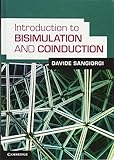An introduction to bisimulation and coinduction / Davide Sangiorgi.
By: Sangiorgi, Davide.
Material type: TextPublisher: Cambridge ; New York : Cambridge University Press, c2012Description: xii, 247 p., UKP 48.00 ill. ; 25 cm.ISBN: 9781107003637.Subject(s): Bisimulation | Coinduction (Mathematics) | Modality (Logic) | Induction (Mathematics) | Computer science | COMPUTERS / Networking / GeneralDDC classification: 004.01/5113 Other classification: COM043000 Online resources: Contributor biographical information | Publisher description | Table of contents only
TextPublisher: Cambridge ; New York : Cambridge University Press, c2012Description: xii, 247 p., UKP 48.00 ill. ; 25 cm.ISBN: 9781107003637.Subject(s): Bisimulation | Coinduction (Mathematics) | Modality (Logic) | Induction (Mathematics) | Computer science | COMPUTERS / Networking / GeneralDDC classification: 004.01/5113 Other classification: COM043000 Online resources: Contributor biographical information | Publisher description | Table of contents only | Item type | Current location | Call number | Status | Date due | Barcode | Item holds |
|---|---|---|---|---|---|---|
| Book | Chennai Mathematical Institute General Stacks | 004.015 SAN (Browse shelf) | Available | 8874 |
Browsing Chennai Mathematical Institute Shelves , Shelving location: General Stacks Close shelf browser
Includes bibliographical references (p 235-243) and index.
Towards bisimulation -- Coinduction and the duality with induction -- Algebraic properties of bisimilarity -- Processes with internal activities -- Other approaches to behavioural equivalences -- Refinements of simulation -- Basic observables.
"Induction is a pervasive tool in computer science and mathematics for defining objects and reasoning on them. Coinduction is the dual of induction and as such it brings in quite different tools. Today, it is widely used in computer science, but also in other fields, including artificial intelligence, cognitive science, mathematics, modal logics, philosophy and physics. The best known instance of coinduction is bisimulation, mainly employed to define and prove equalities among potentially infinite objects: processes, streams, non-well-founded sets, etc. This book presents bisimulation and coinduction: the fundamental concepts and techniques and the duality with induction. Each chapter contains exercises and selected solutions, enabling students to connect theory with practice. A special emphasis is placed on bisimulation as a behavioural equivalence for processes. Thus the book serves as an introduction to models for expressing processes (such as process calculi) and to the associated techniques of operational and algebraic analysis"--
"Induction is a pervasive tool in computer science and mathematics for defining objects and reasoning on them. Coinduction is the dual of induction, and as such it brings in quite different tools. Today, it is widely used in computer science, but also in other fields, including artificial intelligence, cognitive science, mathematics, modal logics, philosophy and physics. The best known instance of coinduction is bisimulation, mainly employed to define and prove equalities among potentially infinite objects: processes, streams, nonwell- founded sets, etc"--






